California Senate Bill 35 (2017)
California Senate Bill 35 (SB 35) is a statute streamlining housing construction in California counties and cities that fail to build enough housing to meet state mandated housing construction requirements.[1] The bill was introduced to the California State Assembly by State Senator Scott Wiener (D-SF) on December 15, 2016.[2] SB 35 aims to address the California housing shortage by increasing housing supply. The bill was signed into law on September 29, 2017 by Governor Jerry Brown as part of California’s 2017 Housing Package – a set of 15 bills that provide “an injection of new regulatory and financial resources” for cities.[1][2]
| California Senate Bill 35 | |
|---|---|
 | |
| California State Legislature | |
| |
| Enacted by | 2017-18 session of the California State Legislature |
| Enacted | September 29, 2017 |
| Signed by | Jerry Brown |
| Introduced by | Scott Wiener |
| Keywords | |
| California housing shortage, Affordable Housing, California | |
Scott Wiener introduced SB 35 to increase housing supply in cities that are not producing enough housing,[3] by encouraging cities to either increase housing development on their own or be forced to accept housing development. After the bill’s passage, Wiener claimed: “SB 35 will retain local control for those cities that are producing their share of housing, but create a more streamlined path for housing creation in those cities that are blocking housing or ignoring their responsibility to build.”[4]
Provisions
SB 35 requires cities include comprehensive rental market information in their biyearly housing element report and allows developers to submit an application subject to streamlined approval processes in municipalities not meeting Regional Housing Needs Assessments (RHNA).[5]
The development must:
- be on land zoned for residential use.[5][6]
- designate at least 10% of units as below market housing if located in localities that did not meet above moderate income RHNA.[6]
- designate at least 50% of units as below market housing in localities that did not meet low income RHNA.[6]
- not be constructed in an ecologically protected area.[5][6]
- be multi-unit housing and not single family homes.[5]
- pay construction workers union-level wages.[5]
If the development meets all state mandated criteria, localities must approve the project in either 60 days if the development contains less than 150 housing units or 90 days if the development contains more than 150 units of housing.[7] Cities will submit their housing construction progress to the California Department of Housing and Community Development (HCD) every 2 years.[8] If the city fails to meet its RHNA goals at one of these progress checks, streamlining will be in effect for the entire next two-year cycle.[8] SB 35 applies only to the specific income levels not being built for. For example, if a city is building enough market-rate units to meet its RHNA but not enough low-income units, the project can only add low-income units to qualify for quickened approval.[8]
Background
California housing costs are among the most unaffordable in the United States. In 2018, the median San Jose home cost 10 times the median household income; Los Angeles homes cost 9.5 times; San Francisco homes cost 8.9 times; San Diego homes cost 8.1 times.[9] California is the second most expensive state to rent in, in the United States.[10]
California has had a housing shortage since 1970 and ranks 49th among 50 states for housing units per capita.[11] The problem has worsened following the Great Recession as housing development fell to 40,000 units in 2009 and has not reached pre-recession levels.[12] California needs approximately 180,000 units per year to match current growth.[11] Slow housing development combined with high housing demand has increased housing costs in every city in California.
The state’s high rent prices have translated into increased homelessness, more households spending half their income on housing, and an exodus of low and middle income households leaving to states with lower cost of living.[13] The housing shortage negatively impacts the Economy of California.
Wiener introduced SB 35 to increase housing supply and stabilize or decrease home prices.[12] The bill is part of California's 2017 Housing Package, which are 15 small bills devoted to increasing housing affordability.[12] Supporters hope SB 35 will shorten the permitting process for certain developments.[14]
Housing Element Act of 1969
The Housing Element Act of 1969 mandates all cities construct a specified number of low, middle, and market rate housing.[14] Cities are required to construct their RHNA, which the HCD determines every 8 years.[8] The RHNA determines the amount of low-income, moderate income, and market housing each municipality is expected to construct to meet regional housing needs. However, 97.6% of cities in California do not construct the required number of low-income housing units allocated.[14]
"Local control is about how a community achieves its housing goals, not whether it achieves those goals," Wiener said in a statement. "SB 35 sets clear and reasonable standards to ensure that all communities are part of the solution by creating housing for our growing population."[16]
Local officials, however, often disagree with state officials over what these housing production goals should be.[17]
Opposition
The League of California Cities and many municipal governments opposed SB 35 for imposing state control over local planning rules.[6] City governments opposing SB 35 include: Berkeley, Beverly Hills, Encinitas, Palm Desert, Vallejo, San Luis Obispo, Huntington Beach, and Walnut Creek.[6]
Several cities have pursued court cases to stop SB 35 following its passage. Huntington Beach is suing the State of California to stop the enforcement of SB 35. The City Attorney for Huntington Beach, Michael Gates, claims SB 35 “unconstitutionally interferes with the city’s authority to enforce local zoning laws.”[18]
Anti-gentrification groups also opposed SB 35.[19] Activists from the Mission Economic Development Agency suggested the following changes to SB 35 to address low-income household displacement:[19]
- development moratoriums in areas undergoing gentrification
- increased affordable-housing requirements for SB 35 qualification
- limiting the time SB 35 projects have before starting construction
Impact
The impact of SB 35 on housing prices is likely to be minimal due to the standards required to meet streamlining approval.[5] Although SB 35 will increase housing by a few thousand units, the international consultancy McKinsey & Company claims California needs millions of units to meet housing demand and decrease prices.[11] However, the bill may increase below-market housing for the lowest income households.[20]
Ten developments in the Bay Area – totaling approximately 4000 housing units—have invoked SB 35 to expedite the development process.[20] Developers in Los Angeles and San Diego have yet to utilize the law because of lower land costs.[5]
Cities Affected by SB 35
28 cities and counties have met their lower and above moderate income RHNA. 298 jurisdictions have not created enough housing to meet their above moderate income RHNA.[21] Projects in these jurisdictions can qualify for SB 35 housing if developments with 10% of housing units devoted to below market housing.
213 jurisdictions have not created enough housing to meet their above very low and low-income RHNA.[21] Projects in these jurisdictions can qualify for SB 35 housing if developments with 50% of housing units devoted to below market housing.[21]
Vallco Mall Project
The Vallco Shopping Mall redevelopment project in Cupertino is the largest project to have utilized SB 35.[20] The project will include retail and office space, and 2,402 total units of housing. Half of those units, or 1,201, will be designated as below-market rate housing for low and very low-income residents.[7] The project was approved on September 21, 2018 for streamlining under SB 35. The development agency responsible for the Vallco Mall redevelopment project, Sand Hill Property Company, applied for SB 35 streamlining after Cupertino citizens attempted to stop the project via a 2020 referendum.[20]
681 Florida Street
The Mission Economic Development Agency (MEDA), an affordable housing development agency, used SB 35 to expedite construction of a 100% affordable housing development in San Francisco’s Mission District.[20] The development will include 130 housing units devoted to low-income families; 30% of those apartments are reserved for formerly homeless families.[19] Without SB 35, the development would have followed the normal approval process and been delayed for 6 months to a year.[20]
See also
References
- “California’s 2017 Housing Package Frequently Asked Questions"California Department of Housing and Community Development July 2018. Retrieved March 3, 2019.
- “SB35 Legislative History” Accessed March 8, 2019.
- Wiener, Scott “We Delivered On Housing: My Housing Streamlining Bill Passes the Legislature".Medium,” September 14, 2018. Retrieved March 3, 2019.
- “Senator Wiener releases Details on SB 35 – the Housing Accountability and Affordability Act"”Press Release” January 23, 2017. Retrieved March 3, 2019.
- Dillon, Liam “How a new California Law could kill a 30-year-old rule that slowed development in Los Angeles"”Los Angeles Times” October 5, 2017. Retrieved March 3, 2019.
- Hughes, Alison “CA Senate Floor Analyses: SB35"”Senate Rules Committee” September 1, 2017. Retrieved March 3, 2019.
- “FREQUENTLY ASKED QUESTIONS ABOUT SENATE BILL 35 AND VALLCO TOWN CENTER APPLICATION “City of Cupertino” July 19, 2018. Retrieved March 9, 2019.
- Brinklow, Adam “How a new law would let California pressure cities to build more””Curbed,” January 25, 2017. Retrieved March 13, 2019.
- “The State of the Nation’s Housing 2018” “Joint Center for Housing Studies of Harvard University” Retrieved March 13, 2019.
- Hoffower, Hillary “The Salary you need to afford rent in every state, ranked””Business Insider” November 26, 2018. Retrieved March 12, 2019.
- “A Tool Kit To Close California’s Housing Gap: 3.5 Million Homes by 2025” Accessed March 8, 2019.
- Dillon, Liam “Gov. Brown just signed 15 housing bills. Here’s how that’s supposed to help the affordability crisis””Los Angeles Times,” September 29, 2017. Retrieved March 12, 2019
- Del Valle, Gaby “How rising rents contribute to homelessness””Vox” December 14, 2018. Retrieved March 13, 2019.
- Brinklow, Adam “Law will force 97.6 percent of California cities to build more””Curbed,” March 20, 2018. Retrieved March 13, 2019.
- "Construction Permits""California Department of Finance," February 2019. Retrieved March 13, 2019.
- Dillon, Liam (2017-01-23). "California cities would have to make it easier to build houses under new legislation". Los Angeles Times. Archived from the original on 2017-06-07. Retrieved 2018-05-28.
- https://www.latimes.com/california/story/2019-08-22/southern-california-housing-growth
- Brinklow, Adam “SoCal city sues state over SF senator’s housing law””Curbed,” January 28, 2019. Retrieved March 13, 2019.
- “Delivering the Promise of the Mission’s 682 Florida Community Benefit” “medasf,” February 14, 2018. Retrieved March 12, 2019.
- Howard, Robert, Walker, Alexander & Olhausen, Matt “Assessing Sb 35 – Success or Failure?” “Gravel2Gavel,” December 18, 2018. Retrieved March 13, 2019.
- "SB 35 Statewide determination summary"
